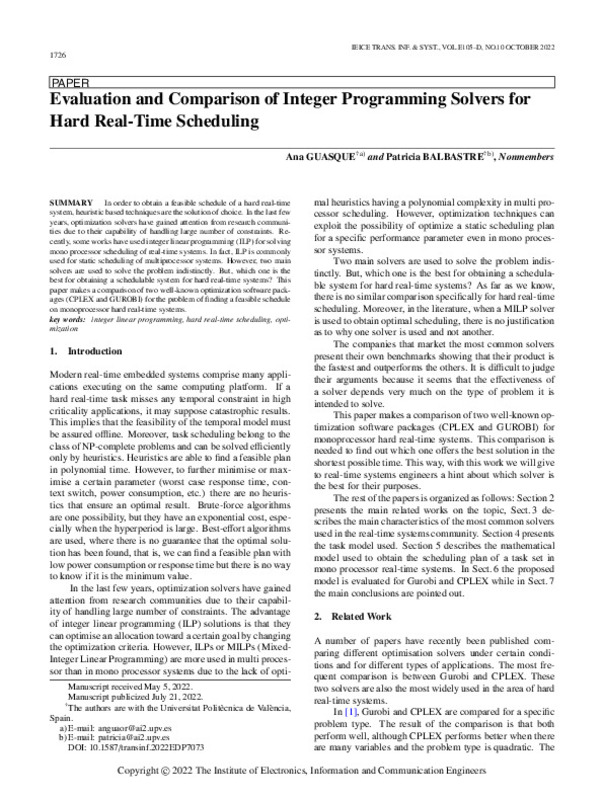[1] R. Anand, D. Aggarwal, and V. Kumar, “A comparative analysis of optimization solvers,” Journal of Statistics and Management Systems, vol.20, no.4, pp.623-635, 2017. 10.1080/09720510.2017.1395182
[2] L.M. Hvattum, A. LÞkketangen, and F. Glover, “Comparisons of commercial mip solvers and an adaptive memory (tabu search) procedure for a class of 0-1 integer programming problems,” Algorithmic Operations Research, vol.7, 2012.
[3] P.G. Saghand and H. Charkhgard, “Exact solution approaches for integer linear generalized maximum multiplicative programs through the lens of multi-objective optimization,” Computers and Operations Research, vol.137, p.105549, 2022. 10.1016/j.cor.2021.105549
[+]
[1] R. Anand, D. Aggarwal, and V. Kumar, “A comparative analysis of optimization solvers,” Journal of Statistics and Management Systems, vol.20, no.4, pp.623-635, 2017. 10.1080/09720510.2017.1395182
[2] L.M. Hvattum, A. LÞkketangen, and F. Glover, “Comparisons of commercial mip solvers and an adaptive memory (tabu search) procedure for a class of 0-1 integer programming problems,” Algorithmic Operations Research, vol.7, 2012.
[3] P.G. Saghand and H. Charkhgard, “Exact solution approaches for integer linear generalized maximum multiplicative programs through the lens of multi-objective optimization,” Computers and Operations Research, vol.137, p.105549, 2022. 10.1016/j.cor.2021.105549
[4] R. Linfati, G. Gatica, and J.W. Escobar, “A mathematical model for scheduling and assignment of customers in hospital waste collection routes,” Applied Sciences, vol.11, no.22, 2021. 10.3390/app112210557
[5] G. Liuzzi, M. Locatelli, V. Piccialli, and S. Rass, “Computing mixed strategies equilibria in presence of switching costs by the solution of nonconvex QP problems,” Computational Optimization and Applications, vol.79, no.3, pp.561-599, July 2021. 10.1007/s10589-021-00282-7
[6] C. Flores-Fonseca, R. Linfati, and J.W. Escobar, “Exact algorithms for production planning in mining considering the use of stockpiles and sequencing of power shovels in open-pit mines,” Operational Research, vol.22, no.3, pp.2529-2553, 2022. 10.1007/s12351-020-00618-x
[7] M. González, J.J. López-Espın, and J. Aparicio, “A parallel algorithm for matheuristics: A comparison of optimization solvers,” Electronics, vol.9, no.9, 2020. 10.3390/electronics9091541
[8] A.P. Punnen, P. Pandey, and M. Friesen, “Representations of quadratic combinatorial optimization problems: A case study using quadratic set covering and quadratic knapsack problems,” Computers and Operations Research, vol.112, p.104769, 2019. 10.1016/j.cor.2019.104769
[9] J. Jablonský, “Recent optimization packages and their comparison,” Hradec Economic Days, vol.7, no.1, 2017.
[10] S. Baruah, “Feasibility analysis of preemptive real-time systems upon heterogeneous multiprocessor platforms,” 25th IEEE International Real-Time Systems Symposium, pp.37-46, 2004. 10.1109/real.2004.20
[11] I. Hong, D. Kirovski, G. Qu, M. Potkonjak, and M.B. Srivastava, “Power optimization of variable-voltage core-based systems,” IEEE Trans. Comput.-Aided Design Integr. Circuits Syst., vol.18, no.12, pp.1702-1714, 1999. 10.1109/43.811318
[12] V.A. Nguyen, D. Hardy, and I. Puaut, “Cache-conscious off-line real-time scheduling for multi-core platforms: algorithms and implementation,” Real-Time Systems, vol.55, no.4, pp.810-849, 2019. 10.1007/s11241-019-09333-z
[13] Y. Sun and M.D. Natale, “Weakly hard schedulability analysis for fixed priority scheduling of periodic real-time tasks,” ACM Trans. Embed. Comput. Syst., vol.16, no.5s, pp.1-19, 2017. 10.1145/3126497
[14] T. Fleming and A. Burns, “Investigating mixed criticality cyclic executive schedule generation,” Proc. Workshop on Mixed Criticality (WMC), 2015.
[15] W. Zhang, Y. Hu, H. He, Y. Liu, and A. Chen, “Linear and dynamic programming algorithms for real-time task scheduling with task duplication,” The Journal of Supercomputing, vol.75, no.2, pp.494-509, 2019. 10.1007/s11227-017-2076-9
[16] B. Rouxel, S. Derrien, and I. Puaut, “Tightening contention delays while scheduling parallel applications on multi-core architectures,” ACM Trans. Embed. Comput. Syst., vol.16, no.5s, pp.1-20, 2017. 10.1145/3126496
[17] A. Azim, G. Carvajal, R. Pellizzoni, and S. Fischmeister, “Generation of communication schedules for multi-mode distributed real-time applications,” Proceedings of Design, Automation and Test in Europe (DATE), Grenoble, France, pp.1-6, March 2014. 10.7873/date2014.306
[18] I.I. Cplex, “V12. 1: User's manual for cplex,” International Business Machines Corporation, 2019.
[19] M. Fischetti, F. Glover, and A. Lodi, “The feasibility pump,” Mathematical Programming, vol.104, no.1, pp.91-104, Sept. 2005. 10.1007/s10107-004-0570-3
[20] Gurobi, Gurobi optimizer reference manual, Gurobi Optimization, 2019.
[21] P.K. Harter, Jr., “Response times in level-structured systems,” ACM Trans. Comput. Syst., vol.5, no.3, pp.232-248, Aug. 1987. 10.1145/24068.24069
[22] M. Joseph and P. Pandya, “Finding response times in a real-time system,” The Computer Journal, vol.29, no.5, pp.390-395, 1986. 10.1093/comjnl/29.5.390
[23] C.L. Liu and J.W. Layland, “Scheduling algorithms for multiprogramming in a hard-real-time environment,” J. ACM, vol.20, no.1, pp.46-61, Jan. 1973. 10.1145/321738.321743
[24] P. Balbastre, I. Ripoll, J. Vidal, and A. Crespo, “A task model to reduce control delays,” Real-Time Syst., vol.27, no.3, pp.215-236, 2004. 10.1023/b:time.0000029049.50766.fa
[25] E. Bini and G.C. Buttazzo, “Measuring the performance of schedulability tests,” Real-Time Systems, vol.30, pp.129-154, 2005. 10.1007/s11241-005-0507-9
[26] V. Brocal, P. Balbastre, R. Ballester, and I. Ripoll, “Task period selection to minimize hyperperiod,” ETFA2011, pp.1-4, 2011. 10.1109/etfa.2011.6059178
[-]









